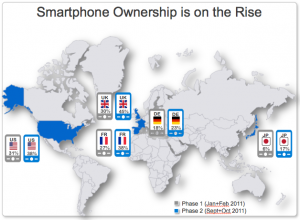Google: Smartphone usage surges globally; good for mobile ads?


Going over a new survey examining smartphone usage in the United States, the United Kingdom, Germany, France, and Japan, Leverich explained on the official Google Mobile Ads blog that more consumers in these nations use a mobile phone (whether it be a feature phone or smartphone) than a computer (desktop or laptop).
But each of these countries saw a significant jump in smartphone usage between the beginning of 2011 and closer to the end of the year.
The United Kingdom, in particular, saw both the biggest increase of usage and the most out of all the countries examined in this survey with an increase from 30 percent of U.K. consumers to 45 percent.
Given the source of this information (Google Mobile Ads), it's quite clear that this rapid climb of the interest in smartphones means a lot more than just more money for mobile OEMs and developers.
With this many more people in the world's leading economies on smartphones, one could argue that most advertisers are already missing a huge opportunity here.
Although the study took place before Google's, Nielsen published a report in September that concurs on the rise of smartphones (at least in the United States) as 60 percent of all new cell phones sold are now smartphones.
Of course, it's not too late for advertisers to start targeting mobile consumers, and as annoying as it might seem to consumers, we will likely see more in the mobile ad space in 2012.
For reference, Google teamed with private research think tank Ipsos on this study, conducted in two parts as demonstrated in the graphic above. Phase 1 of the research was conducted in January and February 2011, while Phase 2 took place during September and October.
[Image via Google]
Related: